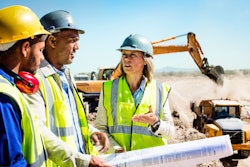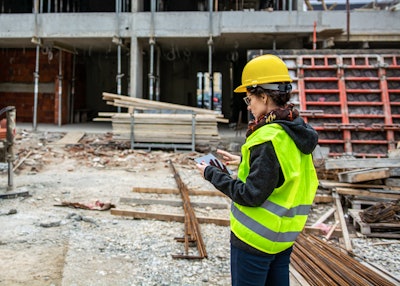
A recession is not in the cards for the U.S. economy, according to the Dodge Construction Network's mid-year forecast for 2023 and 2024.
However, short of a technical recession – or two consecutive quarters of contraction – the construction industry will continue to face a skilled labor shortage.
"We believe that firms will be wary of letting go too many workers for fear of not being able to rehire them once the economy more steadily recovers in the back half of this year," said Sarah Martin, Dodge Construction Network associate director of forecasting.
“It's really that stability in the labor market that allows the economy to show some weakness, but then kind of remain resilient and steadily be on that upward trend through 2024.”
During a recent webinar, she presented Dodge’s mid-year economic outlook.
At the base level, total construction starts dollar amounts are forecast to increase by 2% in 2023 and another 6% in 2024. However, Martin pointed out that without inflation, those numbers look more like a 4% decline in 2023 and a 3% increase in 2024.
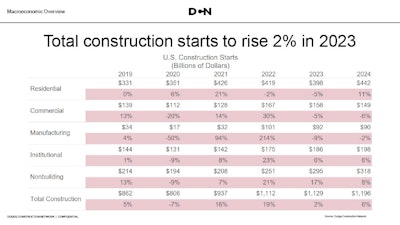 Dodge Construction Network
Dodge Construction Network
“The weakness of single- and multi-family this year is going to pull down starts about 5% and then again no return to growth next year,” she said.
On the commercial side, Dodge is projecting weakness both in 2023 and 2024 driven by fewer office starts and subdued activity in retail and hotels. However, Martin said the primary driver in the decline comes from a plummet in warehouse construction.
Manufacturing saw 200% growth in 2022, so the expectation is a slight decline, while generally maintaining historic levels of activity to the tune of $90 billion.
According to Martin, the institutional side and non-building sectors such as infrastructure that have more public funding are going to be a bit more resilient to any economic slowdown.
“We see that we have steady growth in institutional again, with education and healthcare bolstering strong growth over the next couple of years,” she said. “Nonbuilding includes things like infrastructure, so streets and bridges, environmental, public works, pipelines, electric power, all those things, and a lot of public funding is going to help bolster that in the next few years.”
Assumptions
To lay the foundation of her analysis, Martin explained some of Dodge's macroeconomic assumptions, which act as key drivers in its econometric models when deciding how individual construction sectors will perform over the next five years.
First, inflation continues to be a major issue in the U.S. economy.
"The stagnant, elevated trend and inflation have caused the Federal Reserve to raise interest rates nine times since March 2022," Martin noted.
The most recent increase occurred in May. As a result, she said both consumer and producer price indices showed improvement to core inflation but remain well above where the Fed wants them to be.
Weeks before the mid-year outlook, another rate increase in July seemed unlikely. However, due to the "stubbornly strong" labor market, Martin said Dodge has changed the forecast to a 50/50 shot of another increase.
Within the labor market, she pointed out that another 339,000 jobs were added in May, accelerating growth over the month versus pulling back.
“Conversely, the unemployment rate ticked up potentially showing some signs of a weaker labor market, but not enough to give us that full confidence that the Fed won't raise rates again in July,” Martin added.
The hope is that would likely mark the end of the increase cycle, after which the rates will remain where they are until the Fed slowly begins to lower them in early to mid-2024.
She noted that other risks to the economy include an escalation of the Ukraine/Russia conflict, Taiwan, and OPEC production cuts could undermine current assumptions.
Martin noted that while the forecast is for the U.S. economy to not reach a technical recession, specific sectors of. the construction industry will likely experience some recessionary conditions.
Another key element incorporated into the analysis was the recent banking stress. About two-thirds of commercial real estate loans are funded by small banks, leaving a bit more risk in that segment of the market.
“Loans from small banks in particular experienced substantial growth in 2021 and 2022,” she said. “In the past few months, we've seen sort of that trend crest and then begin to trend downward.”
Martin noted that overall, the banking system is in good shape, especially compared to where it was during the great recession.
However, she added that there could be an impact on commercial real estate. Nearly 50% of current commercial mortgages will be renegotiated between now and 2025, most of which are funded by regional and local banks.
“With the sustained elevation in interest and vacancy rates, it could become a little bit more difficult for developers to get loans for their projects and that will pull down commercial starts throughout the rest of this year and into 2024,” Martin said. “As banking insecurity intensified over the last few months, we've seen commercial planning activity, begin to pull back. As these investment-funded categories are more sensitive to the tightening lending standards and the higher interest rates it makes sense that we're seeing declines in planning projects for things like office buildings, and hotels.”
According to the Dodge Momentum Index, which captures the dollar value of non-residential building projects when they first enter the earliest stages of planning in the Dodge database, data centers, and research and development laboratories have been doing well in bolstering commercial construction activity.
Since the DMI remains well above historical average levels of planning activity, Martin is optimistic about construction activity well into mid to late 2024.
However, she cautioned that another important dimension to consider is that even as all these projects enter planning, they are taking longer to move through the planning process and into groundbreaking.
Martin noted that one of the reasons the projects are taking longer to advance is the shortage of skilled labor.
Reviews of the number of job openings within the construction sector show that it has been volatile in recent months, with lots of spikes and valleys.
“If you were to draw a trendline you would see a rather flat to downward trend over the last year,” Martin said. “Our assumption is this aligns with a sectoral decline we've seen in the housing market.”
Per the forecast, the openings are expected to continue to trend upward as it has in the past few years.
“Dodge thinks that it will continue to be difficult to attract enough skilled labor into the industry,” she said. “Things are moving forward and we're making progress but it's going to continue to constrain the amount of work that we can get done in the industry over the medium term, barring any major technological changes and productivity enhancements.”
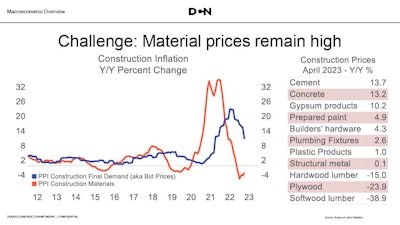
Another reason projects are moving more slowly through the planning process is material prices.
“The composite index is down 3% year over year, and came down considerably in 2022,” Martin said. “It sort of has hit that bottom and is beginning to take upwards again.”
She said the composite index tends to lead the bid price index by about a year.
“In tandem, it makes sense that bid prices have begun to trend downward,” Martin said, acknowledging that prices are still up 10% year over year.
Pricing is expected to remain a challenge through the remainder of 2023.
“Rather than material prices just sort of steadily falling. It's more likely that they'll kind of reach a high normal around the historical average of 3 to 5% because demand for construction activity, remains too strong,” she said.
Stronger sectors of the industry such as manufacturing, research and development labs, data centers, and infrastructure will keep upward pressure on material prices.
By the numbers
For the charts and comments below, the Dodge Construction Network presents the total value of construction starts. This means the numbers have not been adjusted for inflation and they include new construction, additions to existing buildings, and the value of renovations.
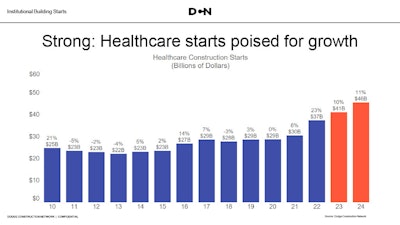 Dodge Construction Network
Dodge Construction Network
Healthcare
Martin described healthcare as one of the biggest opportunities within the institutional space. For Dodge's purposes, healthcare includes inpatient hospitals, nursing homes, and standalone clinics.
About 40% of the total value is from the clinics. She said an additional 20% comes from nursing homes. In both cases, for different reasons, there has been a shift away from both the clinics and nursing homes. Martin said the clinics have fallen by the wayside with the shift of the residential market into the suburbs. Post-pandemic the nursing home development has shifted more into the independent care and adult living communities which fall under the multifamily forecast.
inpatient hospitals account for the remaining 38 to 40% of the market.
“We've seen a huge underinvestment in hospitals over the last decade,” Martin said. “The COVID-19 pandemic exposed our limitations on surge capacity, and caused a revival of interest in renovating and building new hospitals.”
In addition, she said the aging baby boomer population will drive steady hospital demand in the coming years.
The Dodge forecast puts healthcare at a 10% increase in 2023 and another 11% in 2024.
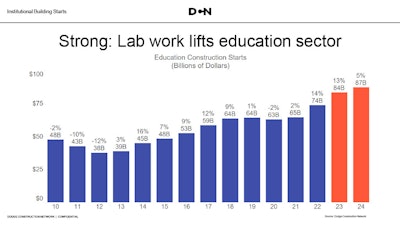 Dodge Construction Network
Dodge Construction Network
Education
"Overall education accounts for a little more than half of all institutional construction activity," Martin said, noting that makes it a major driver for the sector.
In 2022, education starts to increase by 14% according to the Dodge analysis.
“We're expecting that growth to continue over the next two years,” she said. The forecast calls for another 13% increase in 2023 and 5% in 2024.
According to Martin, the strongest segment within education construction in Q1 2023 was lab construction, accounting for about 30% compared to 2022. For its analysis, Dodge includes life science laboratories, associated with universities and colleges and those that are not under education.
Martin pointed out that there has been a surge of research and development labs in the last few years, in particular resulting from interest in and funding for pandemic-related medical developments.
“Compared to 2021, laboratory startups have almost tripled in square footage and value,” she said. “This growth in the laboratory segment is somewhat offsetting the subdued performance that we're seeing in some of the other segments of the education sector.”
On the K-12 and college side, performance was more subdued in 2022 but year-to-date trends are showing steady growth. Also, Martin pointed out that both state and local governments have more reasonable fiscal conditions compared to the early days of the pandemic.
Renovations have been another bright spot on the education side of things with a collective increase of 17% over the last two years.
The primary driver supporting renovations is the Elementary and Secondary School Emergency Relief Fund. A total of $110 billion is allocated to schools to give them a little bit of support after the pandemic.
Martin noted that the expectation was for approximately $15 billion to be spent on the construction and renovation of K through 12 schools.
Labor and supply shortages have prevented many of those projects from advancing and there is a lot of concern that the funds will not be utilized by the deadline of September 2024.
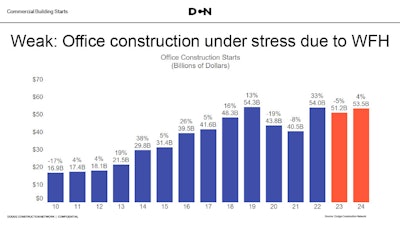 Dodge Construction Network
Dodge Construction Network
Office
The dichotomy is clear between the publicly funded institutional sectors that are doing well such as healthcare and education and the more investment-funded markets that have a bit weaker outlook.
“To nobody's surprise, work-from-home trends pulled down office construction starts over 2020 and 2021,” Martin said. “Those trends are expected to persist in the medium term.”
The National Association of REALTORS has quoted office vacancy rates, increasing from about 9.5% in 2019 to 12% in 2022, again, fueled by remote and hybrid work, layoffs, and higher interest rates.
The 33% growth was boosted by data center projects which Dodge categorizes within its office forecast. They tend to have a higher dollar value which increases the growth.
Martin said data centers accounted for about 30% of the office market last year and increased by over 150%.
“We expect that growth will continue into 2023 but at a more moderate pace of about 20,” she said. “If we pulled data centers out of the forecast, office construction would have risen 15% in 2022.”
Office renovations are the other piece, which typically is another 30 to 35% of the total value. In 2022, renovations accounted for nearly 47% of the total.
Martin said the forecast is for a 5% decline in 2023 with a 4% recovery in 2024.
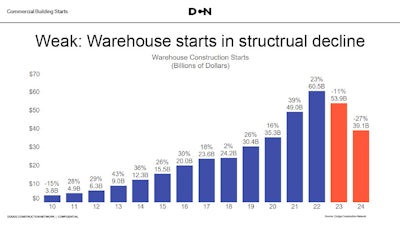 Dodge Construction Network
Dodge Construction Network
Warehouse
The warehouse sector of commercial construction hit historic highs for 12 years, with all but one-year showing double-digit increases. Activity peaked in 2022 and Dodge is forecasting a steady decline this year and into 2024.
"The surge in e-commerce activity pushed warehouses to become the largest non-residential sector tracked by Dodge in 2020,” Martin said.
Amazon and other companies that build space to be used by Amazon accounted for about 16% of all new warehouses started in 2022. However, late in the year, Amazon announced it had overbuilt and planned to curtail much of its new construction activities.
“While this is not the entire market, Amazon's size and importance make it an indicator of the market state,” she said. “In 2023, we expect starts to decline as economic growth slows, and the industry absorbs the large amount of space that has recently come online,” Martin said. “We are forecasting an 11% decline this year, and then another 27% decline in 2024.”
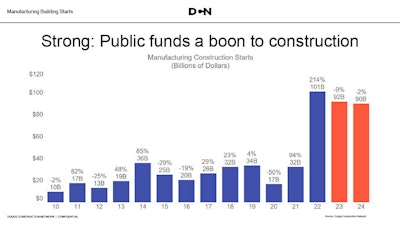 Dodge Construction Network
Dodge Construction Network
Manufacturing
In terms of historical highs, the passage of the CHIPS Act and Inflations Reduction Act, as well as more companies offering to shift production back to the U.S. pushed manufacturing construction to record levels in 2022 to a total of $101 billion.
Martin noted that with the benefits of public funding, planning or construction is underway on multiple projects involving chip fabrication plans, battery plants, food manufacturing plants, steel mills, and lumber mills.
“Many of the sectors that were hit hard with all the supply chain issues that we've seen in recent years,” she said.
With the public funding, Dodge is forecasting a 2% reduction over the next couple of years, however, at $90 billion, it remains at a very high level of activity from a historical perspective.
“Generally, our take is that If we are incorrect in our assumptions here, it will be on the downside, so the market could outperform our expectations that we are forecasting,” Martin said.
 Dodge Construction Network
Dodge Construction Network
Residential
On the residential end of construction, the single-family market plummeted by 15% in 2022. Martin said the market has been hampered by supply, rapid increase in material costs, skilled labor shortages, and higher land costs.
"This lack of supply has pushed housing affordability to the worst that it's been in almost 15 years," she said.
According to her analysis, existing home sales are down 23% from a year ago, while existing home prices are only down about 1%.
“Our belief is basically that the single-family market has hit its bottom and will probably hover around there until the Fed begins to pull back their rates and affordability can markedly improve," Martin said. "We're currently forecasting a 13% decline in starts but by 2024 the market should return to expansion."
Comparatively, the multifamily market was “firing on all cylinders” in 2022.
“Everyone who was being priced out of single-family homes resorted to renting or buying condos and townhomes both of which are tracked in Dodge's multifamily data," Martin said.
The 20% growth in 2022 is the best year for multifamily construction in the past 36 years. Peaking in late 2022, the sector is now seeing a decline.
“Vacancy rates around the country are still pretty low meaning that demand is high but slower economic growth usually correlates to household growth also decelerating,” she said, adding that the deceleration means younger generations are going to cohabitate more with roommates or move back in with parents as the economy slows, reducing the demand for multifamily construction.
Martin further noted that the multifamily market is a hybrid category, being residential, while sharing income properties with the investment portion like hotels or offices.
“When the economy starts to slow down, the investment dollars are going to dry up and that will also slow down demand for multifamily construction projects,” she said.
However, while an 11% decline is forecast in 2024, the levels of construction are anticipated to remain historically high.


